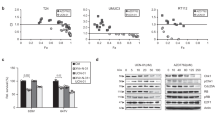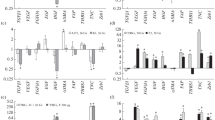Abstract
Drug resistance that occurs during cancer chemotherapy has been a major problem in controlling neoplastic progression. To study the cellular mechanisms of acquired drug resistance we developed 1,25-dihydroxyvitamin D3 (1,25D3)-resistant sublines of promyelocytic leukemia HL60 cells which have increased proliferation rates (Exp. Cell Res., 224, 312, 1996; Cancer Res., 50, 5513, 1996). We report here that the resistant sublines display varying degrees of shortening of the G1 phase as compared to the parental HL60-G cells. Protein levels of cyclins E, D1, D2 and D3 are elevated in these resistant cell lines, and cyclin D1 is especially high in 40AF cells, which has the shortest G1 length. The protein levels of cyclin-dependent kinase (Cdk)2, Cdk4 and Cdk6 are not altered in the resistant sublines. Both Cdk2 and Cdk6-associated kinase activites are increased in the resistant sublines, but not Cdk4 kinase activity. Protein levels of p27Kip1 are not consistently altered in the resistant sublines as compared to the parental HL60-G cells, but are reduced relative to HL60-G cells arrested by 96 h treatment with 1,25D3. Interestingly, the resistant cell lines constitutively express high levels of retinoblastoma protein (pRb), and pRb is highly phosphorylated, indicating that the G1 cyclin/Cdk complexes in the resistant cells are physiologically active. The results suggest that the increased activity of cyclin D/Cdk6, and perhaps cyclin E/Cdk2, lead to rapid hyperphosphorylation of pRb and consequently a shorter early G1 phase, and that in the resistant cells the increased ratio of cyclin E to p27Kip1 results in activation of Cdk2 and contributes to the abrogation of the 1,25D3-induced block to the S phase entry. Additionally, it is apparent that constitutively increased levels of pRb are compatible with increased rates of cell proliferation.
Similar content being viewed by others
Author information
Authors and Affiliations
Rights and permissions
About this article
Cite this article
Wang, Q., Luo, X., Kheir, A. et al. Retinoblastoma protein-overexpressing HL60 cells resistant to 1,25-dihydroxyvitamin D3 display increased CDK2 and CDK6 activity and shortened G1 phase. Oncogene 16, 2729–2737 (1998). https://doi.org/10.1038/sj.onc.1201803
Received:
Revised:
Accepted:
Published:
Issue Date:
DOI: https://doi.org/10.1038/sj.onc.1201803
- Springer Nature Limited
Keywords
This article is cited by
-
Resistance mechanisms to inhibitors of p53-MDM2 interactions in cancer therapy: can we overcome them?
Cellular & Molecular Biology Letters (2021)
-
The phosphoinositide 3-kinase/Akt pathway regulates cell cycle progression of HL60 human leukemia cells through cytoplasmic relocalization of the cyclin-dependent kinase inhibitor p27Kip1 and control of cyclin D1 expression
Leukemia (2003)




